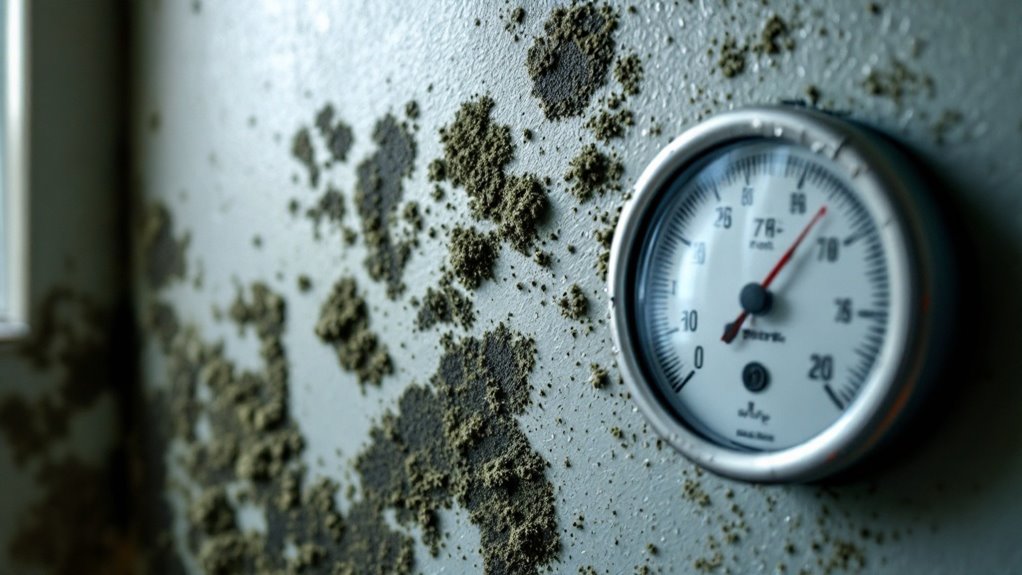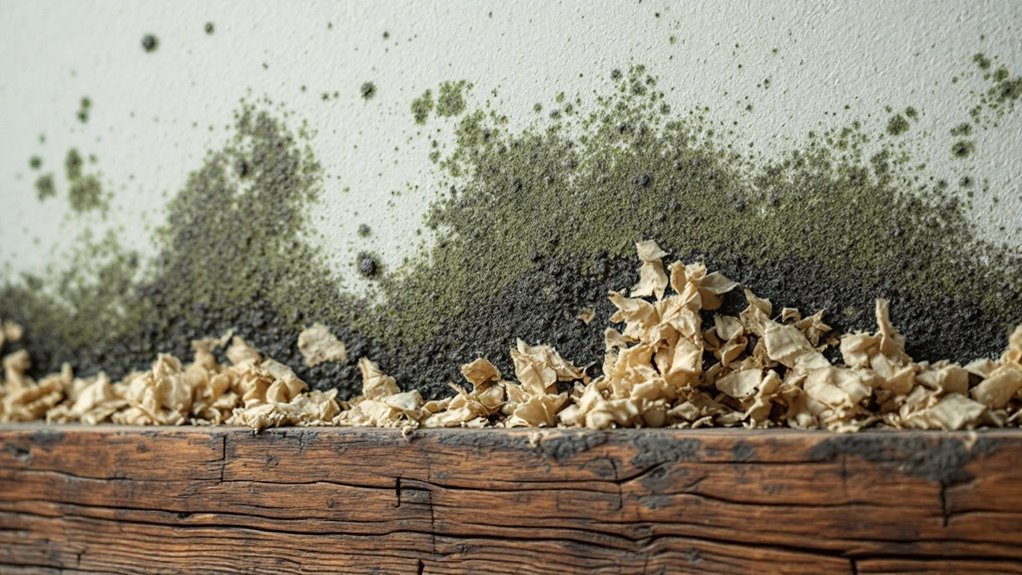Imagine walking into a damp room, the smell of mildew lingering in the air. When a water leak occurs, you might not realize that mold can start to grow in just 24 to 48 hours. This rapid development can pose serious health risks and structural damage if not addressed quickly. What factors contribute to this swift growth, and how can you effectively combat it? Let’s investigate the fundamentals of mold growth after a leak.
Key Takeaways
- Mold can begin to grow within 24 to 48 hours after a water leak occurs.
- High humidity levels above 60% accelerate mold growth in damp environments.
- Porous materials like wood and drywall are particularly susceptible to mold.
- Stagnant air can trap moisture, promoting faster mold development.
- Regular inspections and controlling moisture are key to preventing mold growth.
Understanding Mold Growth Basics

Mold is a sneaky intruder that can thrive in damp environments. It doesn’t take long for mold to take hold, especially when it finds moisture and organic materials like wood or drywall. You might not notice it right away, but mold spores are everywhere, just waiting for the right conditions. Once water leaks occur, mold can begin to grow within 24 to 48 hours. It’s crucial to act quickly; the longer you wait, the more extensive the damage can become. Mold not only affects your home’s structure but can likewise harm your health. Understanding how mold grows helps you recognize the significance of addressing water leaks promptly to prevent infestations that could spiral out of control. Controlling moisture is essential to disrupt the mold lifecycle and minimize its spread.
Key Factors Influencing Mold Development
When a water leak occurs, several key factors can influence how quickly mold develops in your home. First, moisture levels are vital; mold thrives in damp environments, so the longer surfaces remain wet, the faster mold can grow. Next, the type of materials involved matters; porous materials like wood and drywall absorb water and provide ideal breeding grounds for mold. Furthermore, the presence of organic matter, such as dust or food particles, can accelerate growth since mold feeds on these substances. Finally, air circulation plays a role; stagnant air can trap moisture, while good ventilation helps dry out affected areas more quickly. Addressing these factors promptly can greatly reduce the risk of mold infestation. Additionally, maintaining indoor humidity levels between 30-50% is essential for preventing mold growth after a leak.
The Role of Temperature in Mold Growth

While you might not realize it, temperature plays a crucial role in mold growth. Mold thrives in warm environments, typically between 77°F and 86°F (25°C to 30°C). If your home reaches these temperatures after a water leak, you’re creating an inviting atmosphere for mold spores to settle and multiply. Conversely, cooler temperatures, especially below 60°F (15°C), can slow down or even halt mold development. Nonetheless, it’s important to note that while colder conditions may delay growth, they won’t eliminate the spores. If you want to prevent mold, maintaining a stable, cooler temperature can help. Remember, controlling temperature is just one piece of the puzzle in managing mold growth effectively. Additionally, proactive management of indoor humidity is essential to mitigate mold risks in your home.
Impact of Humidity Levels on Mold Proliferation
Humidity levels greatly influence mold proliferation, as these fungi thrive in damp environments. When humidity exceeds 60%, you create an ideal breeding ground for mold spores. These spores can settle on surfaces and rapidly develop into mold colonies if moisture is present. Even small leaks and high humidity can lead to significant mold growth within just 24 to 48 hours. If you live in a humid climate, it’s essential to monitor indoor moisture levels, especially after water leaks. Using dehumidifiers and ensuring proper ventilation can help keep humidity in check. Remember, the quicker you address moisture issues, the less likely mold will take hold and create health issues or damage your home. Stay proactive to protect your space!
Common Materials Susceptible to Mold

When dealing with water leaks, it’s essential to know which materials are most vulnerable to mold. Wood and drywall can easily absorb moisture, creating a perfect breeding ground for mold spores. Carpets and upholstery likewise attract mold, especially when they stay damp for too long.
Wood and Drywall
If you’ve experienced a water leak, you should be aware that wood and drywall are particularly vulnerable to mold growth. These materials can absorb moisture quickly, creating an ideal environment for mold spores to thrive. Within 24 to 48 hours after a leak, mold can start to develop on damp wood and drywall surfaces.
If you leave these materials untreated, the mold can spread rapidly, leading to structural damage and potential health risks. It’s crucial to act quickly by drying out affected areas and removing any damaged materials. Regularly inspecting your home for leaks and moisture can help prevent mold issues before they begin. Staying proactive protects your home and your health from the dangers of mold.
Carpets and Upholstery
Many homeowners don’t realize how easily carpets and upholstery can become breeding grounds for mold after a water leak. When water seeps into these materials, it creates a damp environment that mold loves. If you don’t act quickly, mold can start to grow within 24 to 48 hours. The fibers in carpets and upholstery retain moisture, making it vital to dry them thoroughly and promptly. If you notice any discoloration, musty odors, or visible mold, it’s imperative to take action immediately. You might need to remove and replace the affected materials, especially if the mold has spread considerably. Regularly checking and maintaining your carpets and upholstery can help prevent mold growth and keep your home safe and healthy.
Preventative Measures to Mitigate Mold Growth
To effectively prevent mold growth after a water leak, it’s vital to act quickly and decisively. Here are four key steps you can take to mitigate mold risks:
- Dry the Area: Use fans and dehumidifiers to remove moisture from the affected space within 24-48 hours.
- Inspect for Hidden Moisture: Check behind walls, under carpets, and in crawl spaces to ascertain no damp spots remain.
- Clean and Disinfect: Use a mixture of water and detergent to clean surfaces that may have been affected by water.
- Maintain Proper Ventilation: Confirm areas like bathrooms and kitchens have adequate airflow to reduce humidity levels.
Conclusion
In the battle against mold, time is your enemy and ally. While it can sprout within 24 to 48 hours after a leak, swift action can turn the tide in your favor. By controlling moisture and addressing issues immediately, you can protect your home and health. Remember, neglecting the problem invites mold to thrive, but proactive measures keep it at bay. Stay vigilant and act fast; your future self will thank you for it.
